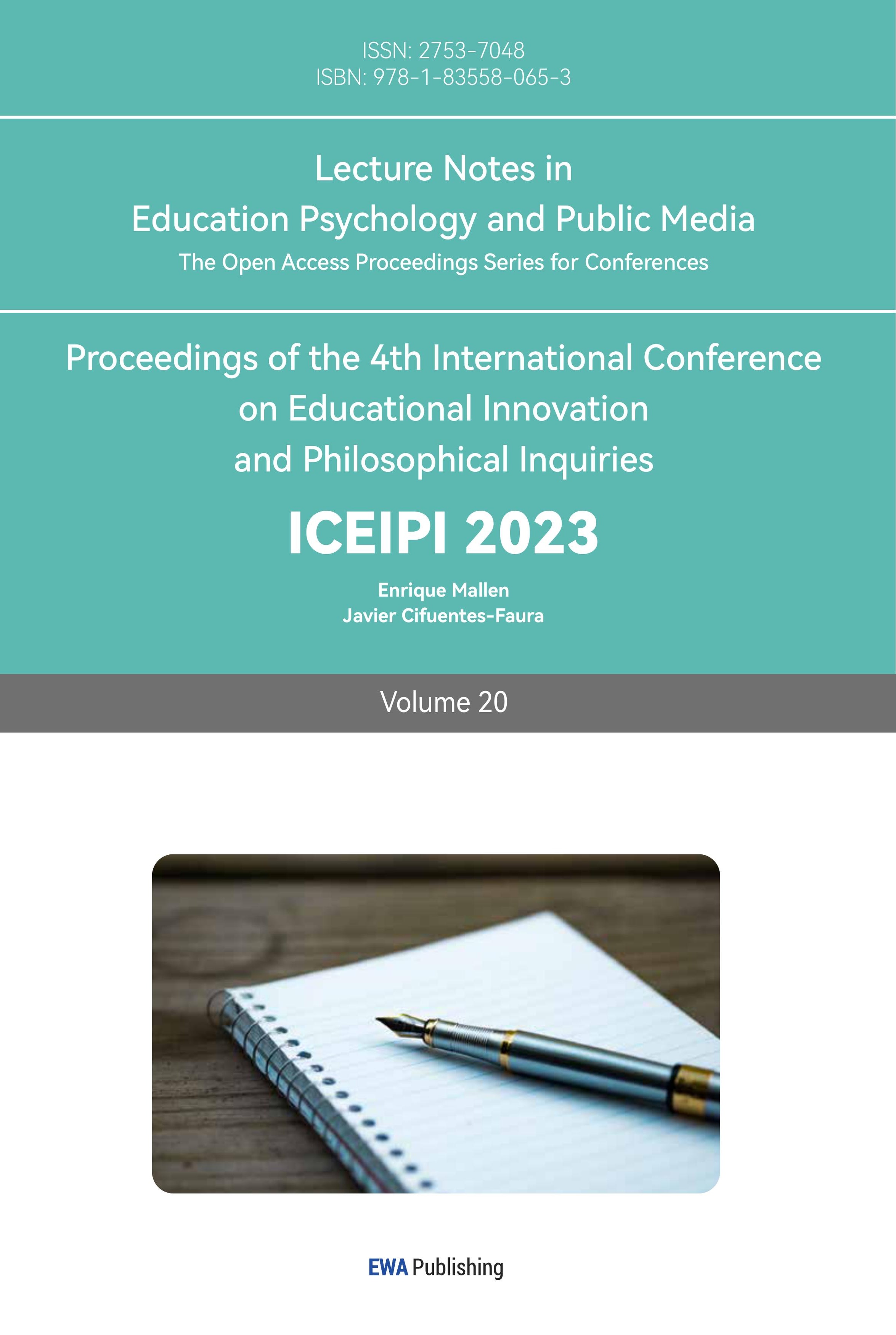References
[1]. Notice of the State Film Administration on the Issuance and issuance of the 14th Five-Year Chinese Film Development Plan [EB / OL]. (2021-11-09) from https://www.chinafilm.gov.cn/chinafilm/contents/141/3901.shtml.
[2]. Notice of the Ministry of Education on the Issuance of the Compulsory Education Curriculum Plan and Curriculum Standards (2022 Edition) [EB / OL]. [2022-04-21] from http://www.gov.cn/zhengce/zhengceku/2022-04/21/content_5686535.htm.
[3]. Du, Nan, and Chuandong Yu. "Application and research of VR virtual technology in film and television art." In Proceedings of the 2020 International Conference on Computers, Information Processing and Advanced Education, pp. 108-114. 2020. https://doi.org/10.1145/3419635.3419667
[4]. Frehlich, Craig. Immersive learning: A practical guide to virtual reality's superpowers in education. Rowman & Littlefield Publishers, 2020.
[5]. Pustu-Iren, K., Sittel, J., Mauer, R., Bulgakowa, O. and Ewerth, R., 2020. Automated Visual Content Analysis for Film Studies: Current Status and Challenges. Digital Humanities Quarterly, 14(4).
[6]. Figure1 : Cinemetrics - originated from an eponymous web-site initiated in 2005 by Yuri Tsivian, a professor from University of Chicago, Department of Cinema and Media Studies.From http://www.cinemetrics.lv.
[7]. Figure2: In 2017, The Quantum Storey Company launched a children's book series "Operation You", which combines traditional printing technology, AR (augmented reality) and VR (virtual reality). From https://publishingperspectives.com/2018/01/ar-vr-enhanced-childrens-book-series-ces/.
[8]. Bennett G, Kruse J. Teaching visual storytelling for virtual production pipelines incorporating motion capture and visual effects. InSIGGRAPH Asia 2015 Symposium on Education 2015 Nov 2 (pp. 1-8)https://doi.org/10.1145/2818498.2818516
[9]. Figure3:The differences between virtual production and traditional film production.From https://www.cgspectrum.com/blog/how-does-virtual-production-work.
[10]. Figure4: Landmark AR effect of "Fengfei Xi'an Bell Tower" in Xi'an and "Rhythm Guangdong Provincial Museum" in Guangzhou.From https://baijiahao.baidu.com/s?id=1649434214126938701&wfr=spider&for=pc.
[11]. Song Q, Wook Y S. Exploration of the application of virtual reality and internet of things in film and television production mode[J]. Applied Sciences, 2020, 10(10): 3450.https://doi.org/10.3390/app10103450.
Cite this article
Chu,Y. (2023). Construction of AR and VR Children's Film and Television Education Curriculum System Based on 5G. Lecture Notes in Education Psychology and Public Media,20,37-46.
Data availability
The datasets used and/or analyzed during the current study will be available from the authors upon reasonable request.
Disclaimer/Publisher's Note
The statements, opinions and data contained in all publications are solely those of the individual author(s) and contributor(s) and not of EWA Publishing and/or the editor(s). EWA Publishing and/or the editor(s) disclaim responsibility for any injury to people or property resulting from any ideas, methods, instructions or products referred to in the content.
About volume
Volume title: Proceedings of the 4th International Conference on Educational Innovation and Philosophical Inquiries
© 2024 by the author(s). Licensee EWA Publishing, Oxford, UK. This article is an open access article distributed under the terms and
conditions of the Creative Commons Attribution (CC BY) license. Authors who
publish this series agree to the following terms:
1. Authors retain copyright and grant the series right of first publication with the work simultaneously licensed under a Creative Commons
Attribution License that allows others to share the work with an acknowledgment of the work's authorship and initial publication in this
series.
2. Authors are able to enter into separate, additional contractual arrangements for the non-exclusive distribution of the series's published
version of the work (e.g., post it to an institutional repository or publish it in a book), with an acknowledgment of its initial
publication in this series.
3. Authors are permitted and encouraged to post their work online (e.g., in institutional repositories or on their website) prior to and
during the submission process, as it can lead to productive exchanges, as well as earlier and greater citation of published work (See
Open access policy for details).
References
[1]. Notice of the State Film Administration on the Issuance and issuance of the 14th Five-Year Chinese Film Development Plan [EB / OL]. (2021-11-09) from https://www.chinafilm.gov.cn/chinafilm/contents/141/3901.shtml.
[2]. Notice of the Ministry of Education on the Issuance of the Compulsory Education Curriculum Plan and Curriculum Standards (2022 Edition) [EB / OL]. [2022-04-21] from http://www.gov.cn/zhengce/zhengceku/2022-04/21/content_5686535.htm.
[3]. Du, Nan, and Chuandong Yu. "Application and research of VR virtual technology in film and television art." In Proceedings of the 2020 International Conference on Computers, Information Processing and Advanced Education, pp. 108-114. 2020. https://doi.org/10.1145/3419635.3419667
[4]. Frehlich, Craig. Immersive learning: A practical guide to virtual reality's superpowers in education. Rowman & Littlefield Publishers, 2020.
[5]. Pustu-Iren, K., Sittel, J., Mauer, R., Bulgakowa, O. and Ewerth, R., 2020. Automated Visual Content Analysis for Film Studies: Current Status and Challenges. Digital Humanities Quarterly, 14(4).
[6]. Figure1 : Cinemetrics - originated from an eponymous web-site initiated in 2005 by Yuri Tsivian, a professor from University of Chicago, Department of Cinema and Media Studies.From http://www.cinemetrics.lv.
[7]. Figure2: In 2017, The Quantum Storey Company launched a children's book series "Operation You", which combines traditional printing technology, AR (augmented reality) and VR (virtual reality). From https://publishingperspectives.com/2018/01/ar-vr-enhanced-childrens-book-series-ces/.
[8]. Bennett G, Kruse J. Teaching visual storytelling for virtual production pipelines incorporating motion capture and visual effects. InSIGGRAPH Asia 2015 Symposium on Education 2015 Nov 2 (pp. 1-8)https://doi.org/10.1145/2818498.2818516
[9]. Figure3:The differences between virtual production and traditional film production.From https://www.cgspectrum.com/blog/how-does-virtual-production-work.
[10]. Figure4: Landmark AR effect of "Fengfei Xi'an Bell Tower" in Xi'an and "Rhythm Guangdong Provincial Museum" in Guangzhou.From https://baijiahao.baidu.com/s?id=1649434214126938701&wfr=spider&for=pc.
[11]. Song Q, Wook Y S. Exploration of the application of virtual reality and internet of things in film and television production mode[J]. Applied Sciences, 2020, 10(10): 3450.https://doi.org/10.3390/app10103450.









